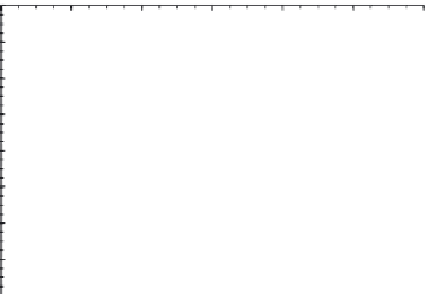Environmental Engineering Reference
In-Depth Information
0.8
0.20
0.7
0.6
0.15
0.5
a
= 2,
b
= 5
0.4
0.10
n
= 5
0.3
0.2
0.05
0.1
0.0
0.00
0
1
2
3
4
5
6
0
2
4
6
8
10
12
14
16
18
20
x
x
Figure 10.3.
uniform probability distribution.
Figure 10.4.
Chi-square probability distribution.
EXAMPLE 10.3
behavior of random variables that are computed
from random variables that are assumed to be normally
distributed. The derived probability distributions
are typically used in describing the probability distribu-
tions of statistics calculated from sample data (called
sampling distributions
), and are also used in hypothesis
testing on whether measured data support the assertion
that they are drawn from a particular population
distribution.
Anecdotal evidence based on historical sampling in a
river indicate that
Escherichia coli
concentrations are in
the range of 1-100 mg/l. Based on this anecdotal report,
estimate the
E.coli
concentration that is likely to have
an exceedance rate of 10%.
Solution
Since there is no indication that any values are more
likely to be measured than others, it is appropriate to
assume a uniform probability distribution between 1
and 100 mg/l. Hence,
a
= 1 mg/l,
b
= 100 mg/l, and the
probability distribution of the concentration is given by
Equation (10.39) as
10.4.1 Chi-Square Distribution
The
chi-square distribution
is the probability distribu-
tion of a variable obtained by adding the squares of
ν
normally distributed random variables, all of which have
a mean of zero and a variance of 1. That is, if
X
1
,
X
2
, . . . ,
X
v
are normally distributed random variables with mean
of zero and variance of 1, and a new random variable
χ
2
is defined such that
1
1
100 1
1
99
f c
( )
=
=
=
(
mg/L
)
−
1
b a
−
−
Therefore, if
c
90
is the concentration with a 10%
exceedance probability
ν
∑
X
i
i
2
2
χ
=
(10.41)
=
1
1
99
(
100
−
c
)
⋅
=
0 10
.
then the probability density function of
χ
2
is defined as
the chi-square distribution and is given by
90
which yields
c
90
= 90.1 mg/l. If more data becomes
available, it might be possible to refine this estimate of
c
90
based on the distribution of the measurements.
− −
(
1
ν
/ )
2
−
x
/
2
x
e
f x
( )
=
,
x
,
ν
>
0
(10.42)
ν
/
2
2
Γ
( / )
ν
2
where
x
=
χ
2
, and
ν
is called the number of
degrees of
freedom
. The shape of the chi-square distribution is
illustrated in Figure 10.4. The mean and variance of the
chi-square distribution are given by
10.4 DERIVED PROBABILITY
DISTRIBUTIONS
Several useful probability distributions are derived
from the normal and log-normal distributions. Most of
these derived probability distributions describe the
µ
=
ν σ
,
2
=
2
ν
(10.43)
2
2
χ
χ















Search WWH ::

Custom Search